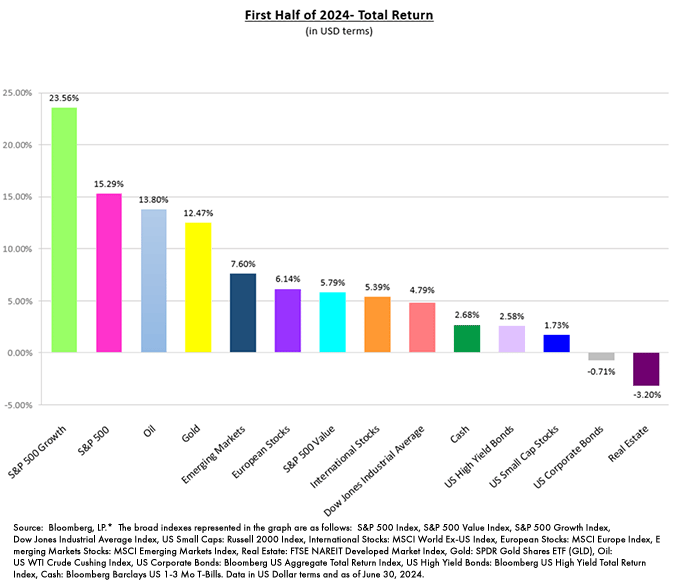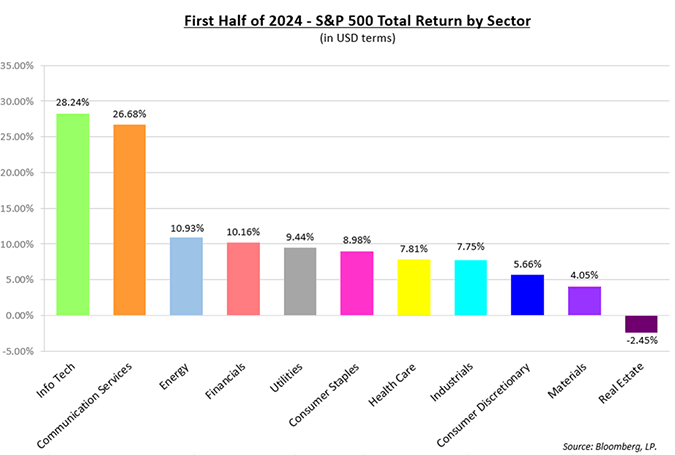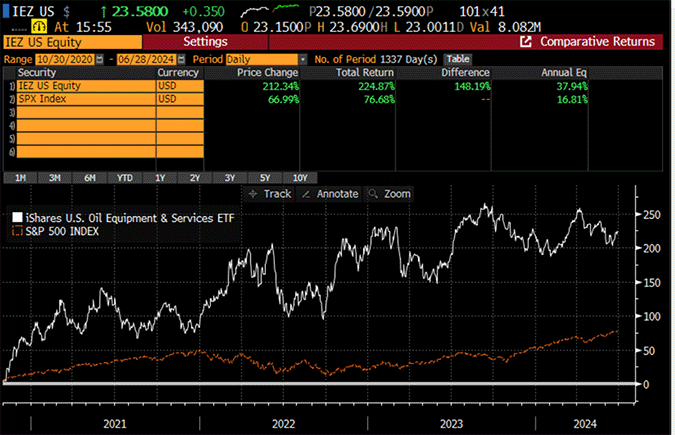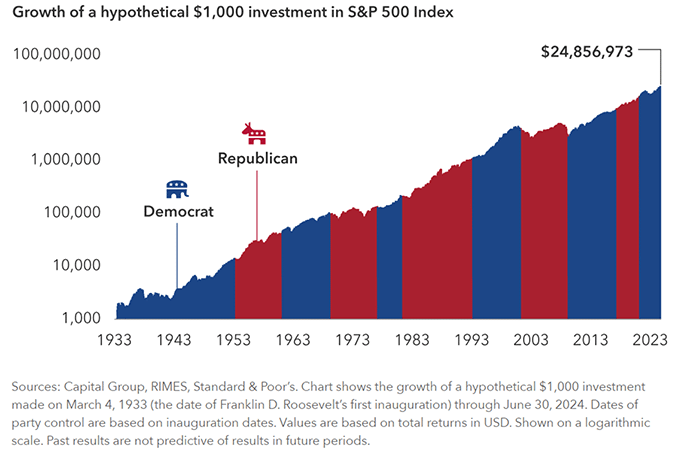CKBlog: The Market
Tuesday, July 23, 2024
2024 Semi-Annual Review
by The CastleKeep Team

2024 has been another strong year for global assets, led once again by large technology focused companies in the United States. Nearly all global asset classes have posted gains thus far, with the interest rate sensitive US Corporate Bonds and Real Estate being the only major asset classes to post paper losses year-to-date through June 30th, 2024.

The same is true for the sectors within the S&P 500 Index, with real estate being the only to post paper losses through June 30th. It has paid to be an owner of “risk” assets thus far—especially so if your portfolios were concentrated in large capitalization stocks and stocks associated with Artificial Intelligence (AI). The S&P 500 Index, representing a market-cap weighted index of the 500 largest US publicly traded companies, was up over 15% through June 30th. However, it wasn’t just about the largest companies in the S&P 500 Index. The S&P 500 Equal Weighted Index, which aims to hold an equal percentage in each of the 500 companies in the index, also posted a gain of 5% for the first half of the year through June 30th. By all accounts, it was a strong start to the year across the board.
Strong returns were not only experienced in the US. Please see below the performance of various global stock markets (all results are in US Dollar terms and sourced from Bloomberg):

If at the start of 2024, an investor sought shelter in longer duration bonds, it was painful to watch global stock markets continue higher. The iShares 20+ Year US Government Treasury Bond ETF (ticker TLT) was down -5.64% through June 30th. But there may be hope for fixed income investors as most analysts are predicting that Central Banks around the world, including the US, are inching closer to an interest rate cutting regime. As interest rates fall, bond prices will rise (all else equal).
The Fed and the Potential for Rate Cuts
The European Central Bank has begun cutting their benchmark interest rates. Economists that follow these markets closely are predicting the US is next, with the first rate cut coming as soon as September. Why? The rate of price increases has been slowing down (note that this means prices continue higher but at a decreased pace). The following chart is from the Wall Street Journal:

Borrowers will cheer potential rate cuts. Savers may not, as many have grown accustomed to earning relatively high yields on money market funds and US Treasury Bills. Pundits predicted significant rate cuts coming into 2024 which have not materialized (several leading investment banks predicted more than six cuts during the year). While it appears that rate cuts are on the horizon, we would not be surprised if murky readings on the Consumer Price Index (CPI) take multiple cuts off the table later this year. History tells us that inflation is tough to tame, as inflationary pressures wind their way through the economy.
Artificial Intelligence (AI)
AI stocks have continued their strong performance which began in 2023. It would have taken an aggressive strategy of overweighting AI stocks, or those that stand to gain from the adoption of the technology, to keep up with the returns of the overall market or even outperform major indexes.
Most folks will reference the spectacular returns of Nvidia and Super Micro Computer when describing the returns of AI stocks in 2024. With year-to-date eye-popping gains through June 30th of +149.50% for Nvidia (ticker: NVDA) and +188.24% for Super Micro Computer Inc. (ticker: SMCI), who could blame them? But the AI theme also helped propel the likes of other large cap tech company shares.
For Nvidia, the original hype has been supported by actual revenue growth:
- Fiscal Year 2023: $27 billion (actual)
- Fiscal Year 2024: $60.9 billion (actual)
- Fiscal Year 2025: $120.5 billion (Bloomberg projections)
Clearly, there has been plenty to be excited about. But ask anyone who has invested through the earliest adoptions of groundbreaking technologies and they will advise caution. Like the first railroad, automobile, and internet companies before, the earliest winners aren’t always the best long-term investments. So, invest wisely.
We often reference Cisco Systems as an example. In the middle of the Dotcom Bubble, Cisco was the largest publicly traded company in the world. After all, if you wanted access to the internet, you needed Cisco routers and its network equipment. At its high on March 31, 2000, shares of Cisco stock traded at $77.31. On June 30th, 2024 it traded at $47.51. Nearly 25 years later, despite an exponential growth in revenue and earnings by the company, an investor who purchased shares at its peak are still looking at an unrealized capital loss on the price of the shares (they have, however, collected dividends along the way). The total return since March 31st, 2000 through June 30th, 2024 is -0.41% per annum. Hardly attractive.

There’s no guarantee that Nvidia and Super Micro won’t continue higher in perpetuity. But given historical comparisons, we wouldn’t bet the ranch on it.
Elections
We began writing this piece as the pressure mounted for President Biden to step aside after his first debate performance. By the end of our writing, there was an assassination attempt on former President Trump and President Biden formally announced he won’t be seeking re-election. Political views aside, as advisors to clients around the world, it was tragic and embarrassing that the US has come to this. We will leave it to the political analysts to debate recent events. For this piece and for the benefit of our clients, we will focus on how elections may (or may not) impact global markets this calendar year.
But first, a disclaimer. The attempted assassination of former President Trump on July 13th taught us that literally anything can happen. There is certainly no sure-fire way to profitably invest through any short time period, let alone one as politically contentious as today. Past performance is no guarantee of future returns. Nonetheless, below are four things to consider for the markets and this year’s US election(s).
- Presidential election year’s markets tend to be strongest toward the end of the election year. This shouldn’t be surprising. Investors despise uncertainty. Early in an election year, especially in those where the contest appears close, many investors look to de-risk their portfolios (become net sellers of stocks) leading up to November as they attempt to digest the ebbs and flows of the political rancor. As the outcome becomes clearer, and there is a blueprint for the winner’s four-year agenda, the rules of the road become more evident, and many investors get “back in”.
In the following graph provided by J.P. Morgan Private Bank- Investment Strategy Research and Insights, we can see some statistics around previous election years:

- Focus less on the candidate and more on policies. It’s hard to ignore the rhetoric and stump speeches, but we would advise an investor to do just that. Regulations, tax policies, infrastructure spending, deficit management and tariffs are all more important than a sound bite just posted on Twitter/X.
Conclusions aren’t always obvious and often-times are counterintuitive. Take Biden’s and Trump’s clear and differing view on the energy complex as an example. President Biden has been in favor of further regulation against the fossil fuel industry. Intuitively, this may have convinced investors to shy away from investing in oil related stocks. But greater regulations may also mean less drilling which can translate to higher prices (lower supply) and therefore higher profits for existing energy companies—a phenomenon we have just lived through since Biden was elected in 2020.
Please see the performance of the iShares Oil and Exploration ETF (ticker: IEZ). It is up nearly +225% since November 1st, 2020, almost tripling the performance of the S&P 500 Index.

- Congress is up for grabs, too. From an investor’s perspective, gridlock isn’t the worst outcome as it means a better chance for the status quo (less changes to laws, regulations, and tax policy). Remember, investors fear uncertainty so a divided Congress or a President from the opposing party that controls Congress historically provided a better investing climate than when one party controls both the Executive and Legislative branches.

Source: Carsson Group Whitepaper Midyear Outlook ‘24
Every other presidential election in history was likely described as “the most important of our time.” Yet the US has survived and even thrived through the previous 59 outcomes—as has the stock market. True, the policies of the Executive and Legislative branches do matter, but they have not proven to have an outsized impact on stock and bond markets over time. Well-managed corporations, just like humans, adapt to the changing landscapes.

Source: Capital Group, Advisor Insights Ebook: Guide to investing in an Election Year, June 2024
The second half of 2024 will test our patience. Rhetoric will be at an all-time high. Expect to feel anxious and at times compelled to make drastic changes to your investment approach. When experiencing those feelings, please remind yourself that your parents and grandparents likely felt similar or more severe anxiety (World War II, Vietnam War as examples). We would all but guarantee that if asked today, they would advise you to stay the course even in the darkest hours. Statistically (with the benefit of hindsight of course), this advice would have been correct.
By most accounts, WW II began on September 1st, 1939. On that day the Dow Jones Industrial Average traded below $150.
On November 1st, 1955, then President Eisenhower sent troops to train the Army of the Republic of Vietnam, (an action many credit as the start of the conflict), the Dow traded just above $450.
On June 30th, 2024, it closed at $39,118.
Short-term investment objectives require a more nuanced approach. But if your objective is to build wealth over the long-term, it has always paid to stay the course. We are here to help you do just that, regardless of which political party is in control.
We would like to end by thanking our clients for the trust and confidence placed in us. The last several years have been remarkable and full of market-moving events. 2024 has been no different. We are grateful for your commitment to our investment process and for entrusting us with the responsibility to help plan and realize your financial objectives.
Sincerely,
The CastleKeep Team
July 23, 2024
A PDF version of this column: 2024_Semi-Annual_Market_Review




